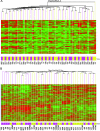Prognostic gene expression signatures can be measured in tissues collected in RNAlater preservative
- PMID: 16436632
- PMCID: PMC1867564
- DOI: 10.2353/jmoldx.2006.050056
Prognostic gene expression signatures can be measured in tissues collected in RNAlater preservative
Abstract
Gene expression signatures have the ability to serve in both prognostic and predictive capacities in patient management. The use of RNA as the starting material and the lability of this analyte, however, dictate that tissues must be snap-frozen or stored in a solution that can maintain the integrity of the RNA. We compared pairs of snap-frozen and RNAlater preservative-suspended tissue from 30 such paired lymph node-negative breast tumors and 21 such paired Dukes' B colon tumors. We assessed the correlation of gene expression profiles and prediction of recurrence based on two prognostic algorithms. Tissues stored in RNAlater preservative generated expression profiles with excellent correlation (average Pearson correlation coefficients of 0.97 and 0.94 for the breast and colon tumor pairs, respectively) compared to those produced by tissues that were snap-frozen. The correlation in the prediction of recurrence was 97% and 95% for the breast and colon tumor pairs, respectively, between these two types of tissue handling protocols. This novel finding demonstrates that prognostic signatures can be obtained from RNAlater preservative-suspended tissues, an important step in bringing gene expression signatures to the clinic.
Figures



Similar articles
-
Preservation of RNA for functional analysis of separated alleles in yeast: comparison of snap-frozen and RNALater solid tissue storage methods.Clin Chem Lab Med. 2007;45(10):1283-7. doi: 10.1515/CCLM.2007.281. Clin Chem Lab Med. 2007. PMID: 17727312
-
Comparison of frozen and RNALater solid tissue storage methods for use in RNA expression microarrays.BMC Genomics. 2004 Nov 10;5:88. doi: 10.1186/1471-2164-5-88. BMC Genomics. 2004. PMID: 15537428 Free PMC article.
-
Simultaneous Evaluation of the Preservative Effect of RNAlater on Different Tissues by Biomolecular and Histological Analysis.Biopreserv Biobank. 2018 Dec;16(6):426-433. doi: 10.1089/bio.2018.0055. Epub 2018 Nov 28. Biopreserv Biobank. 2018. PMID: 30484701
-
Using microarray analysis as a prognostic and predictive tool in oncology: focus on breast cancer and normal tissue toxicity.Semin Radiat Oncol. 2008 Apr;18(2):105-14. doi: 10.1016/j.semradonc.2007.10.007. Semin Radiat Oncol. 2008. PMID: 18314065 Review.
-
Gene expression profiling of breast cancer.Annu Rev Pathol. 2008;3:67-97. doi: 10.1146/annurev.pathmechdis.3.121806.151505. Annu Rev Pathol. 2008. PMID: 18039137 Review.
Cited by
-
The role of the pathology department in the preanalytical phase of molecular analyses.Cancer Manag Res. 2018 Apr 12;10:745-753. doi: 10.2147/CMAR.S150851. eCollection 2018. Cancer Manag Res. 2018. PMID: 29695931 Free PMC article.
-
Nucleic acids enrichment of fungal pathogens to study host-pathogen interactions.Sci Rep. 2019 Dec 2;9(1):18037. doi: 10.1038/s41598-019-54608-x. Sci Rep. 2019. PMID: 31792282 Free PMC article.
-
Comparison of the efficiency of different cell lysis methods and different commercial methods for RNA extraction from Candida albicans stored in RNAlater.BMC Microbiol. 2019 May 14;19(1):94. doi: 10.1186/s12866-019-1473-z. BMC Microbiol. 2019. PMID: 31088364 Free PMC article.
-
Up-regulation of neutrophil gelatinase-associated lipocalin in colorectal cancer predicts poor patient survival.World J Surg. 2014 Aug;38(8):2160-7. doi: 10.1007/s00268-014-2499-x. World J Surg. 2014. PMID: 24682311
-
Your Blood is Out for Delivery: Considerations of Shipping Time and Temperature on Degradation of RNA from Stabilized Whole Blood.bioRxiv [Preprint]. 2024 Aug 26:2024.08.24.609519. doi: 10.1101/2024.08.24.609519. bioRxiv. 2024. Update in: Anal Chem. 2025 Jan 28;97(3):1635-1644. doi: 10.1021/acs.analchem.4c04591. PMID: 39229214 Free PMC article. Updated. Preprint.
References
-
- Butte A. The use and analysis of microarray data. Nat Rev Drug Discov. 2002;1:951–960. - PubMed
-
- Meltzer PS. Spotting the target: microarrays for disease gene discovery. Curr Opin Genet Dev. 2001;11:258–263. - PubMed
-
- Huang E, Ishida S, Pittman J, Dressman H, Bild A, Kloos M, D’Amico M, Pestell RG, West M, Nevins JR. Gene expression phenotypic models that predict the activity of oncogenic pathways. Nat Genet. 2003;34:226–230. - PubMed
-
- Ramaswamy S, Ross KN, Lander ES, Golub TR. A molecular signature of metastasis in primary solid tumors. Nat Genet. 2003;33:49–54. - PubMed
-
- van de Vijver MJ, He YD, van’t Veer LJ, Dai H, Hart AA, Voskuil DW, Schreiber GJ, Peterse JL, Roberts C, Marton MJ, Parrish M, Atsma D, Witteveen A, Glas A, Delahaye L, van der Velde T, Bartelink H, Rodenhuis S, Rutgers ET, Friend SH, Bernards R. A gene-expression signature as a predictor of survival in breast cancer. N Engl J Med. 2002;347:1999–2009. - PubMed
Publication types
MeSH terms
Substances
LinkOut - more resources
Full Text Sources
Other Literature Sources
Medical
Molecular Biology Databases
Miscellaneous

